People
‘It’s Time to Wake Up’: Artist Cecilia Vicuña on Her Monumental Soft Sculptures and Their Hard Message About Planetary Survival
The Chilean artist's major commission at Tate Modern opens today in London.
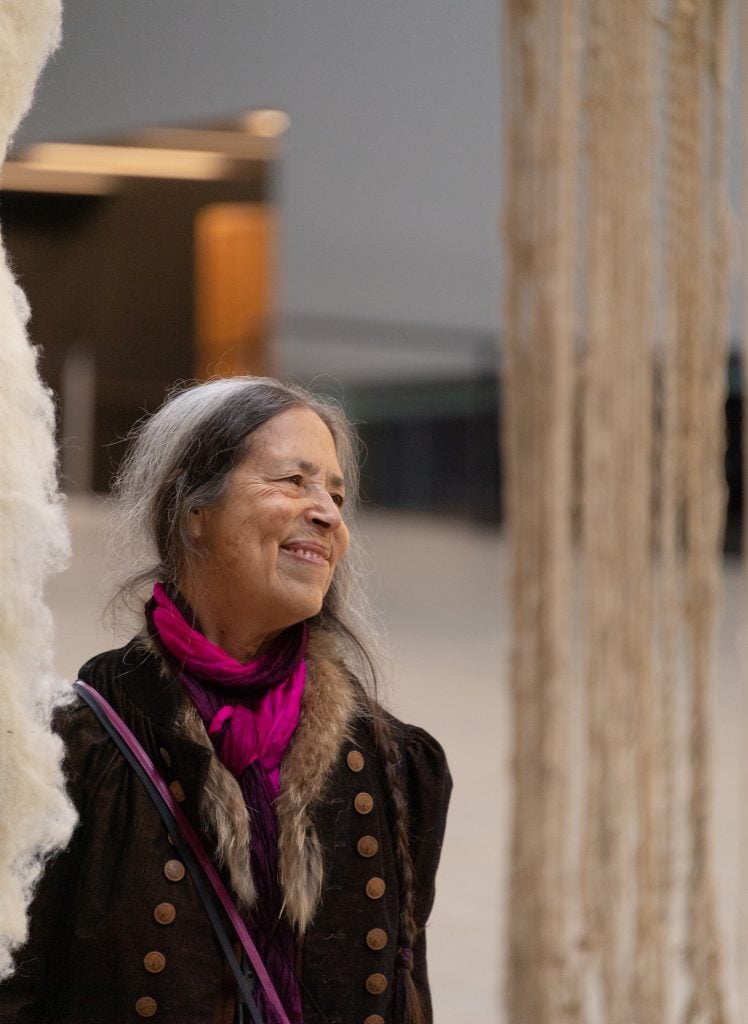
The Chilean artist's major commission at Tate Modern opens today in London.

Hettie Judah

Cecilia Vicuña has lost her voice. To achieve an interview we must huddle, masked, so that I can hear her: whispering, rasping, barely sculpting sounds with the passage of her breath. Each word is hard won. She speaks with exquisite purpose.
Vicuña considers the particular atmosphere of Tate Modern’s Turbine Hall to be the culprit, though we might also blame her accelerated schedule. It’s been a non-stop year for the Chilean artist and poet. In March, she was awarded a Golden Lion for lifetime achievement ahead of her presentation at the Venice Biennale. In May, a huge survey opened at New York’s Guggenheim. It’s enough to make anyone feel giddy, let alone hoarse.
For five weeks she turned the former industrial space at the heart of Britain’s largest gallery into a functioning studio. “For me, the Turbine Hall is beautiful,” she said, reminding me of the noble materials used in this mid 20th century structure. This chamber is full of history: “the coolness and the dampness of whatever pollution contamination happened here is still with us. To work in a space like that, it’s also a healing process. We cannot deny or negate what the industrial era has given us, we have to incorporate it but reorient it now. So that is a gift.”
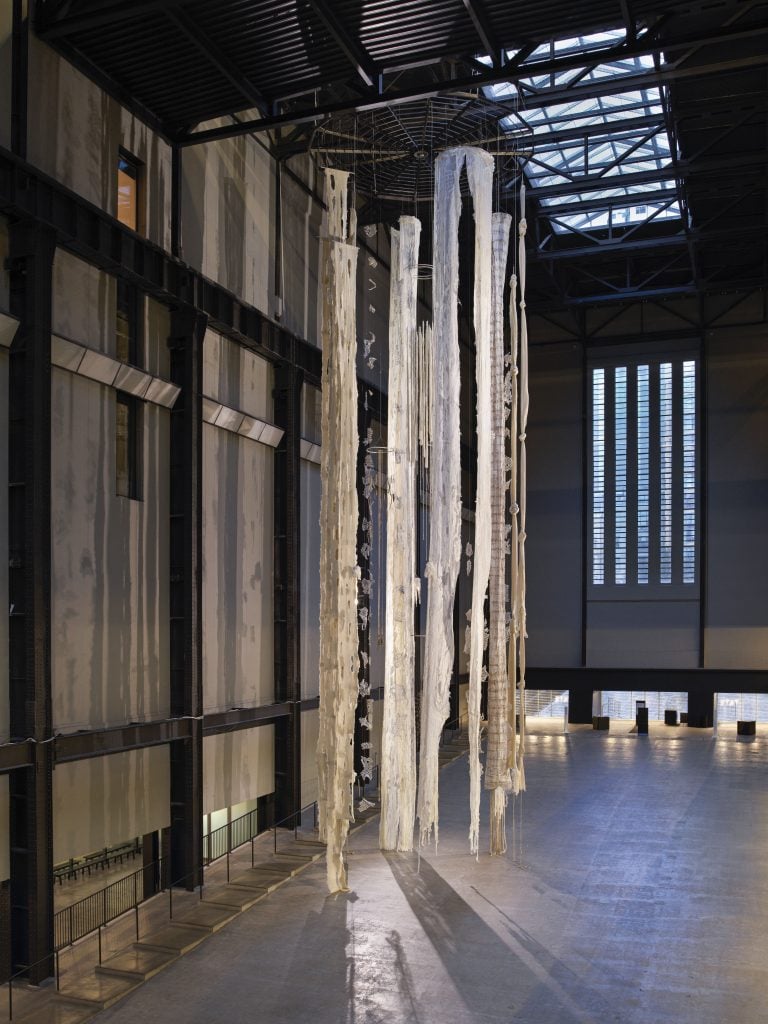
Hyundai Commission: Cecilia Vicuña: Brain Forest Quipu Installation View at Tate Modern 2022. Photo © Tate Photography (Matt Greenwood)
To achieve this healing, Vicuña worked with teams of women from local Latin American communities to knot, weave, paint, and thread two gargantuan suspended columns, each skeletal white, and strung with sea glass, hag stones, ceramic sherds, driftwood, and bird bones. They hang at either end of the Turbine Hall as a part of “Brain Forest Quipu.” One part is imagined to be the mother, the other the child. The quipu is a knotted structure that Andean civilizations used as a counting and communication system: ancient knowledge that is worlds away from the clamorous, coal-fuelled power station on the bank of the Thames that now houses Tate Modern. “Why does the quipu feel good there? It feels good, because it’s bringing the breeze in, it’s bringing the sound, the touch, the softness. And soft and hard work well together.”
Vicuña has a history with London. She recalls watching the British countryside from the plane window as she arrived to take up a place at the Slade School in 1972. “I was coming from a land that was still mostly wild. In Chile there was, of course, a lot of cultivated land. But everywhere, there were big chunks of wilderness. And my first thought, coming to England was ‘Oh, my God, this is a manicured landscape! Everything has been controlled.’” Searching for whispers of the untamed drew her to the Thames: “my first strong relationship was with the river because the river was still wild, still alive.” Fifty years later, the Thames now furnishes the fragments Vicuña strung within her Brain Forest Quipu.
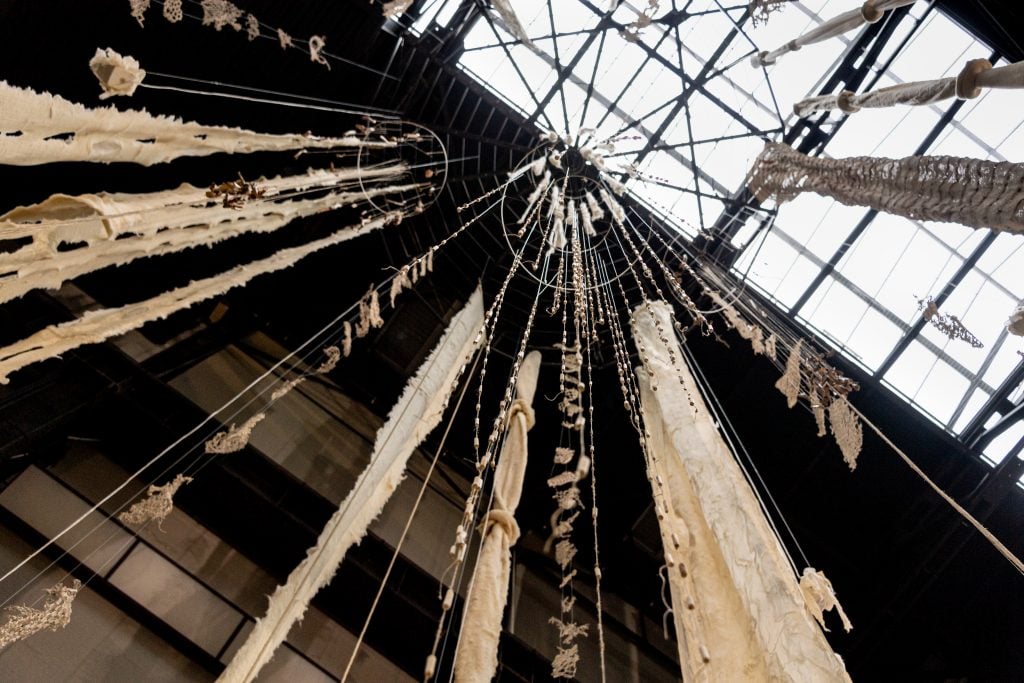
Cecilia Vicuna, Turbine Hall, Tate Modern
She was in London during the 1973 Chilean coup d’état: “It was a very violent political scene back in the 70s. When the military coup happened in Chile, it was a conservative government here. And they wanted us out immediately.” She was at the Slade at the time where there was just a handful of Chilean students. “We were all supposed to leave the country right away,” she told me. “A union of lawyers defended us for free. To get asylum, I had to demonstrate that I would be killed in Chile.” They used an illustrated book of poems she had published months after the coup called Sabor a mi as the evidence. “That book defended me,” recalled Vicuña.
Living in exile, New York has been her base since 1980. It is emotional to be back in Britain, she said: “I see again this kind of violent Conservative government—against the people, against the environment—how is it possible that there has been so little evolution in 50 years?”
Living a precarious, peripatetic life in exile meant that much of Vicuña’s early work was lost, though not all by happenstance. “There was a lot of violence against my art. Most of my art was destroyed by family and friends: everybody thought it was worthless. Thank God there were a few exceptions, and some works were saved!” Looking back to paintings from the 1960s and 70s, she now feels “that the works that were destroyed really didn’t belong to me, or to the people who destroyed them. They belong to the people of the world.” Thus, she has been painting doubles of the lost works; some of them will be shown by Lehmann Maupin at Frieze London, which opens on Wednesday, October 12. “They’re not exactly like they were,” the artist noted. “If you put them together, you will see tons of things are different. But it is a process of resurrection, like rebirthing what was killed by violence.”
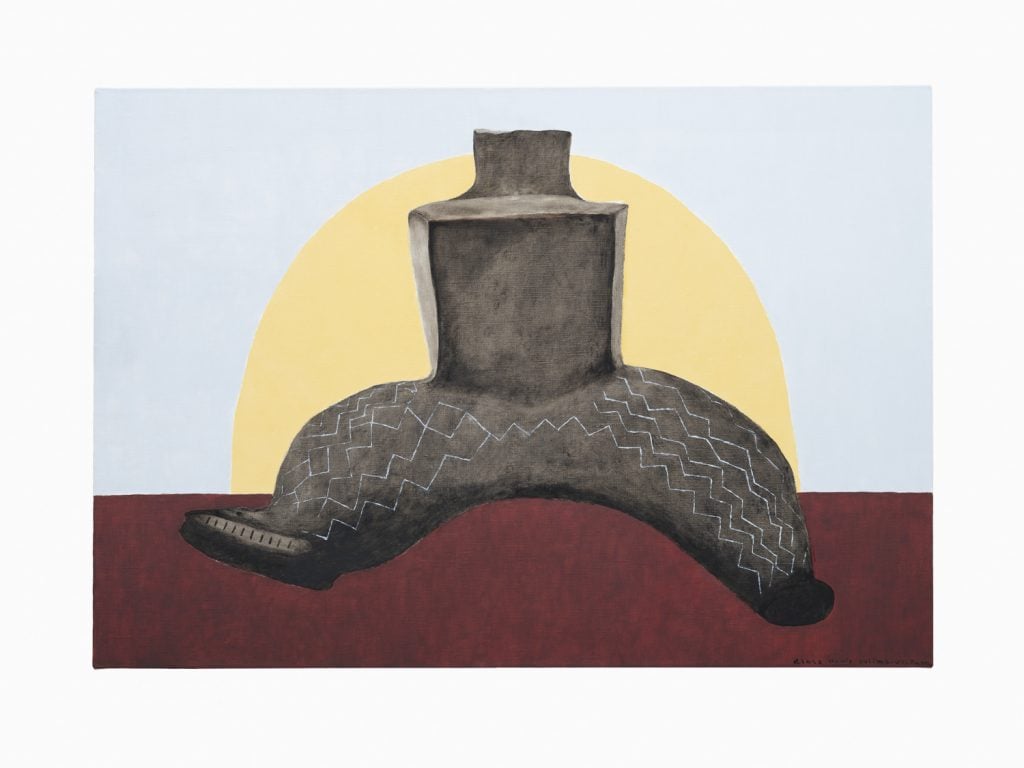
Cecilia Vicuña Diosa Lluvia Colima (2021). Courtesy the artist and Lehmann Maupin, New York, Hong Kong, Seoul, and London
I wonder what will happen to the Brain Forest Quipu next April when the piece vacates the Turbine Hall. Will it be broken up, or preserved? No one has discussed it, she told me, “which is very telling, isn’t it? I think we’re at a time when we don’t know what’s permanent anymore, because we are killing all life forms. Even our possibility of surviving as a species is in question.”
The question of planetary survival is what drives Vicuña. She is of Indigenous Diaguita descent on her mother’s side, and has worked with many groups of environmental activists and land-use campaigners, notably in Brazil. An audio work, called the sound quipu, plays from speakers embedded in the columns. Made with Colombian composer Ricardo Gallo, it blends field recordings with fragments of poetry and Indigenous music. Videos stationed around Tate broadcast the damage done by extractive industries in the Amazon region in bald terms.
The bleached whiteness of Brain Forest Quipu evokes dead zones: desiccated forest, sun-flayed skeletons, dying coral. The “brain forest” of the title is not her invention Vicuña said: it relates to mycelial networks and other non-human intelligences. “Brain forest is how the earth thinks of itself. The earth is the brain forest. And we’re killing all the forests of the world—temperate, arctic, Amazonian, desert shrub—all of them are being murdered,” said Vicuña. “It’s time to wake up.” This, then, is an elegiac work, a mourning space, an invitation to action. On Friday, it will host a ritual held in response to the climate catastrophe, led by artists, activists, scientists, and environmentalists.
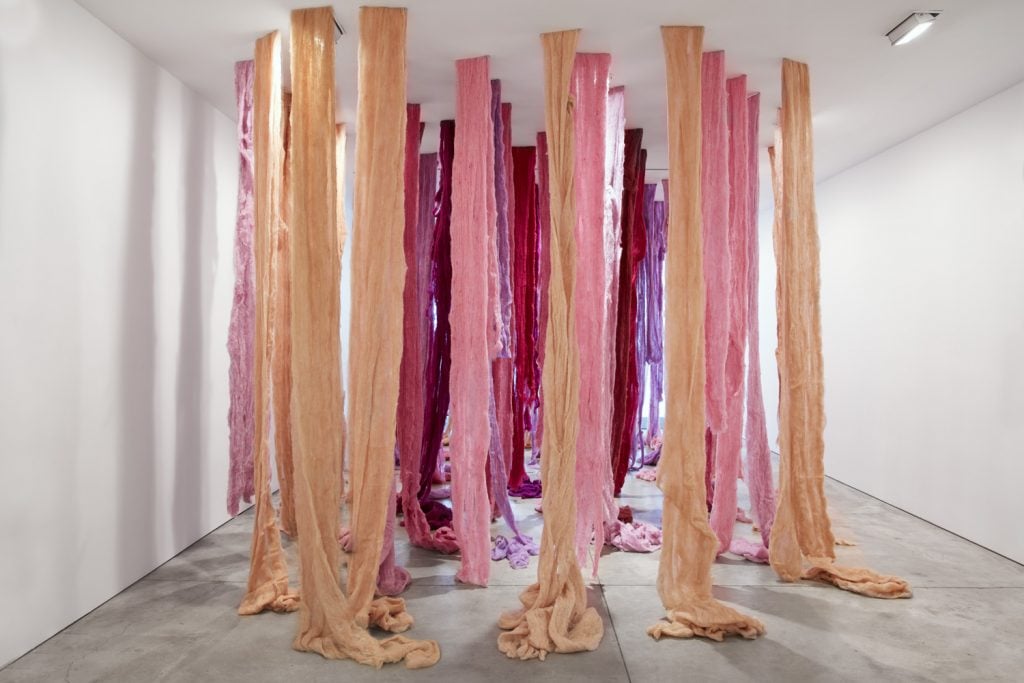
Cecilia Vicuña Quipu Womb 2017 © Cecilia Vicuña. Photo: Joe Humphrys
After decades of being known as a poet than an artist, Vicuña entered her period of greatest demand as she entered her 70s, following the exhibition of Vicuña’s visceral Quipu Womb at Documenta 14 in 2017. Since the start of the pandemic, she has created seven monumental quipus, often through the hands of people with whom she shares no verbal language. For a 25-metre-high commission in Shanghai last year, she used Zoom to demonstrate the knotting process to a group of Chinese weavers. “The knowledge of my hands was transmitted via the screen, to the knowledge of their hands without words. And they understood how to do a quipu. The tactile knowledge of human hands is universal.” The newly collective act of constructing these light yet monumental works has reinforced Vicuña’s sense of interconnectedness. “We are an individual and a collective at once. This is the teaching,” she said, quiet, but with a burning sense of purpose.
Cecilia Vicuña: Brain Forest Quipu, Tate Modern, London, October 11, 2022—April 16, 2023